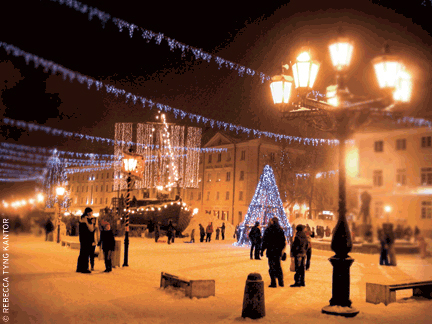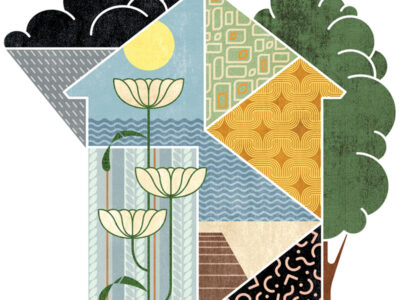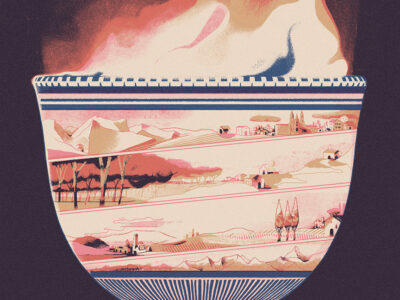
On Louis Kahn’s trail in Estonia, teasing out the facts from the fairy tale.
By Rebecca Tyng Kantor
Before I came to Estonia, everyone told me to expect white nights in the summer. What they didn’t say was that the nights in winter would be just as bright.
I had visited the country before, but never in December. Every day until four in the afternoon, the sky is overcast, and the town of Tartu is a collection of pleasant neoclassical buildings. But their rectilinear facades disappear after sunset. Christmas lights are switched on and create the appearance of a different city, far brighter than the daylight one. Icicle lights arch across the streets, outlining imaginary vaults. Blue and white bulbs are bunched together like chandeliers. Above the columns of the university’s main building, lights form a trompe l’oeil gingerbread lattice. And the entire chimera is reflected in the layer of snow that has been on the ground a month already.
As I walk through the city center this afternoon, I find Tartu’s artificial cityscape more disconcerting than pretty. Of course, the lack of natural light—and, as my mother constantly warns me, a lack of vitamin D—seems to make most people living here feel disoriented and depressed in the winter. But that’s not the only reason I feel this way. My sense of belonging in Estonia is starting to seem as much of an illusion as the cityscape I see around me.
This shouldn’t necessarily be the case. I actually have roots in Estonia: my grandfather was born here. The rest of his life followed the rags-to-riches trajectory of the classic immigrant. When he came to America, he had many strikes against him—immigrant, Jewish, his face disfigured by scars—but, by the time he died, Louis Kahn Ar’24 Hon’71 had earned a reputation as one of the most prominent architects of the 20th century. Still, the part of his life that always seemed the most fairy-tale-like to me wasn’t its ending, but its beginning: Estonia.
Although I never knew my grandfather, my grandmother often told me about Saaremaa, the Estonian island where he was born. She described the medieval castle that she believes was an early influence on his ideas about monumentality. In fact, many people think that my grandfather’s sense of architecture was shaped by his childhood in Estonia [“Journey to Estonia,” Jan|Feb 2007]. Like Estonians, my grandfather recognized the importance of light, and it played an integral role in his designs.
Lately, though, I’ve been wondering about my grandfather’s origins. Was his story really a fairy tale come true? Or just a made-up story?
The seeds of doubt were planted six years ago, when I met three Estonian architects who were visiting Philadelphia to do research on my grandfather. I told them how excited I was at the prospect of visiting Saaremaa for the conference they were planning. They glanced at each other before turning back to me.
“Yes,” one replied, “but, you know, your grandfather probably wasn’t really from there. There are hardly any Jews in Estonia. And I don’t think there were ever any Jews on Saaremaa.”
I got the same response when I went to Estonia and took a trip to the Saaremaa Archival Library. “If your family did live here,” I was told, “they must have been the only Jewish people on the island.”
Finally my family was able to locate the birth certificates of my grandfather and his siblings. All three births had been registered not on Saaremaa, but in Pärnu, a city on the mainland.
There’s another reason why I question my sense of belonging here—one that makes the musings on my grandfather’s birthplace a moot point. No matter where in Estonia my grandfather was born, there’s a good chance that he and I will always be viewed as outsiders in this country.
Estonians see themselves as a homogeneous group. One scholarly book on the country’s peasant life takes pains to identify Estonians as members of the “Nordic” race. And an Estonian-American friend has warned me not to tell anyone that I’m part Jewish. “Estonia is an anti-Semitic country, Becca.”
I can see why my friend has this impression. Many Estonians are unapologetic about their country’s role in aiding the Nazis. In one town’s local history museum, I saw an exhibit on World War II that featured a photograph of Estonian civilians with their arms draped around the shoulders of German soldiers, grinning at the camera. No mention was made of the Jews from the area who had been taken into the woods and shot during Nazi occupation. I heard a woman contrast Estonia’s attitude toward the Holocaust with Germany’s repentant one. “In Estonia,” she said, “we haven’t yet said that the Estonians who helped the Nazis were bad.”
After spending four months here, I know that many Estonians have nothing against Jewish people. But in their minds, Jews still aren’t quite … Estonian.
Walking through Tartu, I pass through the Christmas market in the Town Hall Square. International students are jostling and calling out to each other as they line up to buy glögi, the Estonian mulled wine. Now I arrive at the apartment of an Estonian architect and his family. As I take off my snow boots by the door, I exchange shy “tere” greetings with the three young kids. The adults move to the kitchen table, where we drink herbal tea and munch Kalev chocolates.
The architect and his wife ask about my research on my grandfather. I tell them about the thoughts I had on my way here.
The architect’s wife laughs, pointing to her dark, tilted eyes. “Well, I think some of my ancestors must have come from Mongolia.” She pauses. “You know, Estonia has been conquered by so many different people—the Germans, the Danes, the Swedes, the Russians … No matter what people think, no one here has ‘pure’ Estonian blood.”
Maybe she is right, I realize. Apart from a brief stint of independence in the early 20th century, Estonia was ruled by foreign powers for centuries until it regained independence in 1991. This new country has probably felt as much of a need to create a myth of identity as my grandfather did when he came to the United States.
I think back to two summers ago, when I made my second trip to Saaremaa. I met the research director of the Saaremaa Museum, who’d long been interested in my grandfather’s connection to the island. The two of us took a walk around the town of Kuressare. He told me that there had, in fact, been a small number of Jews on the island before World War II. Although my grandfather probably wasn’t born on the island, records show his mother’s family did live here. As we passed the town square, the man pointed to a yellow building. Two of my grandfather’s uncles had owned a butcher shop in its cellar, he told me. A few streets away was a grassy lot where the Hotel St. Petersburg once stood. My great-great-grandfather had operated a workshop on its ground floor.
Later, the collections manager of the University of Pennsylvania Architectural Archives pieced together information to conclude that my grandfather had probably stayed with his mother’s family from the time he was three to when he was five years old. So even if my grandfather hadn’t been born on Saaremaa, his earliest memories were likely of the island. The stories of his childhood might not have happened exactly as he described, but they weren’t just myths, either.
As I say goodbye to the architect and his family, I feel more cheerful. It’s almost dinnertime, but instead of heading straight back to my dorm I decide to take a detour along Lutsu Street. Suddenly, I see an opening to a courtyard. In a town as small as Tartu, how could I never have noticed this before?
I step inside. I seem to be the midst of a Christmas market—although the centerpiece, instead of an evergreen tree, is a bonfire. The flames are striking against the dusk of the sky. Around the edge of the courtyard are roofed stalls made of dark beams. The vendors watch me as I look at their wares: woolen mittens and scarves, juniper wood handicrafts, gingerbread cookies covered in elaborate swirls of icing.
This market couldn’t be more different than the raucous one in the Town Hall Square. Here the atmosphere is hushed, almost secretive; I feel as if I’ve been granted access to a traditional core of the town. In their headscarves and overcoats, the few other customers could just as easily belong to Tartu’s medieval past as to the present day.
And now, still without speaking, the customers are all turning to leave. Probably they’re just eager to return to the warmth of their homes. But I could almost believe that if we don’t go before the Town Hall clock chimes the hour, the whole market might vanish into the air, taking us along with it.
The next day I came back to Lutsu Street with my camera. I walk up and down the block, but I can’t find the entrance to the courtyard. In a way, I don’t really want to. I’d like to think of the market as a magical place that eludes documentation, an illusion that appeared just for me. Sometimes, it takes a fairy tale to make you belong.
Rebecca Tyng Kantor C’08 is currently enrolled in the MA program for Creative Writing at the University of East Anglia in Norwich, England.




